Fast Infrared Detector for Time-Domain Astronomy
Abstract
1. Introduction
- An analysis of different algorithms proposed for generating automatic triggers to enable data acquisition;
- Programs developed for emulating astronomical bursts with the goal of generating a preliminary database of possible transients;
- Software tools developed for burst classification by using pattern recognition (PR) techniques developed for artificial intelligence (AI);
- Considerations about the possible noise-canceling strategy;
- Considerations about the future use of artificial neural networks for pattern recognition.
1.1. A New Astronomy
1.1.1. Fast Radio Bursts
1.1.2. Time-Domain Astronomy
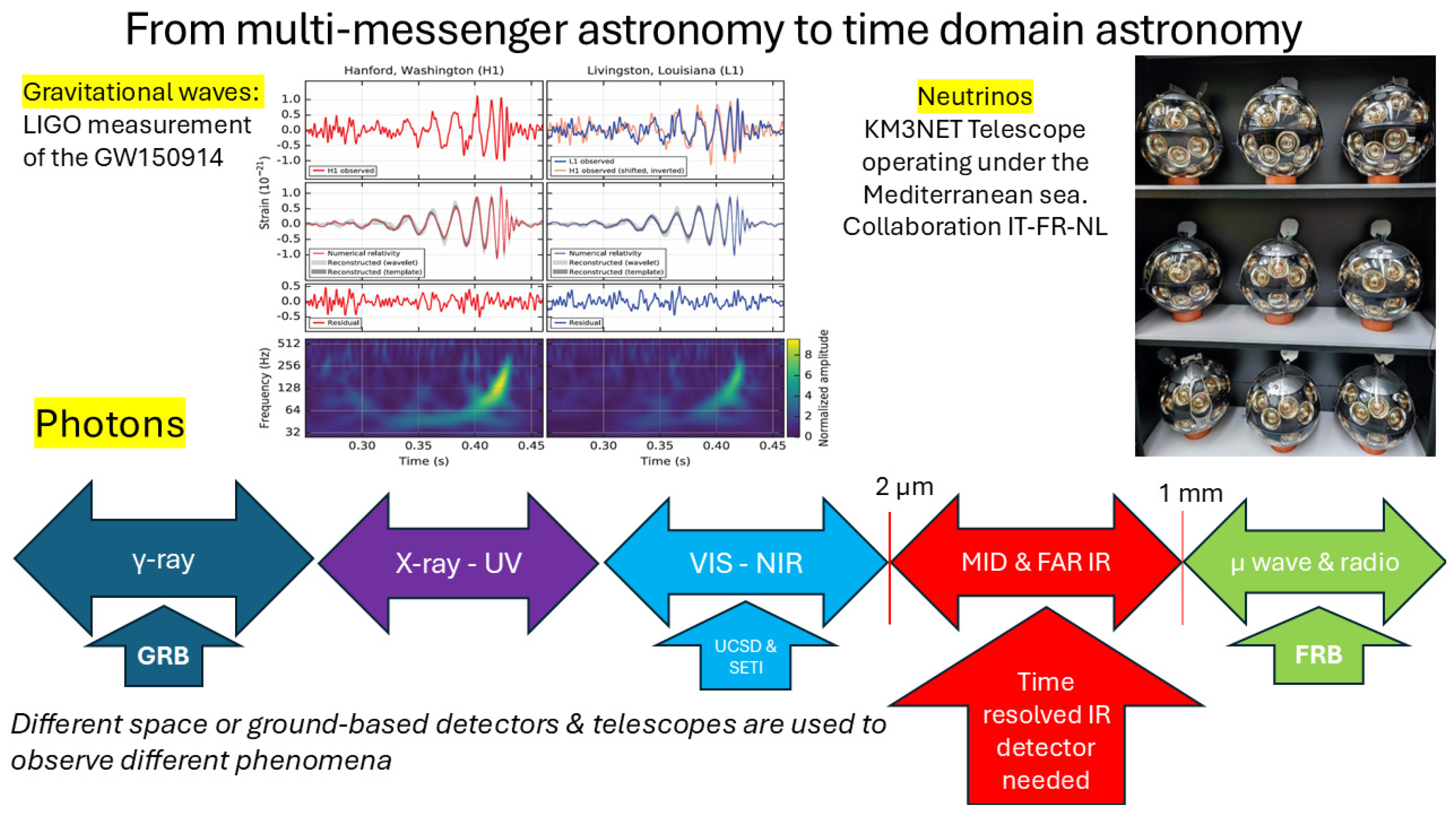
1.1.3. Directionality of the Detection
2. Instrument Design Basic Concepts
2.1. The Interstellar Medium as a Particle Accelerator
2.2. DAFNE and SINBAD
2.3. Diagnostics for Circular Accelerators
2.4. Particle Beam Fast Instabilities
- τ = the difference in time with respect to the rest position;
- n = the bunch number;
- dr = the radiation damping factor = 1/(growth rate);
- ωs = the angular frequency of the synchrotron oscillations;
- F = the force generating the instability effect.
- Nb = number of buckets;
- RL = ring length;
- fRF = radio frequency;
- c = speed of light.
2.5. Trigger to Record the Instabilities
- Generated by the machine master clock;
- Generated by bunch injection into the ring;
- Correlated with arising instability.
2.6. How to Identify the Instability Source
3. Time-Resolved Infrared Detection
3.1. Basics of the Project
3.2. Synchrotron Radiation Infrared Beamline
3.3. HgCdTe Detectors
- Fast response to the inputs, in the order of 1 ns.
- Good specific detectivity D* and responsivity R in the mid-IR range selected for the telescope (2–12 µm) where D* is defined aswhere A is the active detector area, Δf is the frequency interval and NEP is the Noise-Equivalent Power.D* = ((A ∗ Δf)1/2/NEP),The photodetector responsivity R is given in Ampere per incident radiant power (A/W) units and iswhere η is the quantum efficiency, q is the electron charge, h is the Plank constant and f is the frequency of the optical signal.R = (η ∗ q)/(h ∗ f)
- Low noise.
- Operating at room temperature (preferably): this feature makes a ground-based telescope more compact and easily transportable, even if the use of Peltier’s cells would be a practical solution.
3.4. InAsSb Detectors
4. Tests and Results
4.1. Front End Analog Module
4.1.1. Test Carried Out at SINBAD
4.1.2. Performance of HgCdTe Detectors
Considering the realistic possibility for the engineered system to use an 80 dB amplification stage equivalent to a 10 k linear gain, the detection system shall be sensitive to 1 photon for 0.1% of the infrared bandwidth (δλ/λ) by using the needed 80 dB amplification.
4.1.3. Performance of InAsSb Detector
4.2. Data Acquisition System
4.3. Trigger
4.3.1. Trigger Module Design
- The machine master clock from the accelerator timing system during data collection at the infrared beamline.
- The sync output from a pulse generator in the case of signal simulation.
- A trigger threshold level selected by the operator.
- A smart automatic trigger generated by the astronomical signal or by a comparison between the astronomical signal and the dark signal. It can be implemented in different ways that are discussed below. Basically, the software module must be designed to calculate a movable threshold level that, when exceeded, enables the trigger for data acquisition.
- A trigger forced by a command from the operator.
- An external trigger coming from other astronomical systems operating for multi-messenger astronomy.
- A self-diagnostics trigger via a pulse generator for testing purposes.
- Fixed data length based on the operator choice;
- Data record length limit based on technological considerations about the available data memory;
- Threshold comparison of the input value based on a percentage of trigger threshold (considering if the transient is terminated).
4.3.2. Trigger Modules
- Select the trigger threshold value manually by operator.
- If the A signal is >threshold, start recording the acquisition.
- For every time slot, compute the D signal background average.
- Apply a gain factor to the D signal average to obtain the trigger threshold. The gain should be evaluated by the operator, but it is 1 by default. The gain factor should take care of the possible hardware discrepancy of the semiconductors or external noise.
- If the A signal is >threshold, start recording the acquisition.
- For every second, compute the A and D background average or fit in the last second.
- Calculate the average of the last five fits for both the A and D inputs.
- Evaluate the difference between the A- and D-averaged background.
- Apply a gain factor [0:2] to the difference result to obtain the trigger threshold. The gain should be evaluated by the operator, but it is 1 by default. The gain factor has to take care of the possible hardware discrepancy of the semiconductor.
- If the A signal is >threshold, start recording the acquisition.
- For every time slot, compute the D background average.
- Add a delta value to the D average to obtain the trigger threshold.
- If the A signal is >threshold, start the recording of the acquisition.
4.4. Pattern Recognition Software for Transient Classification
4.4.1. Fast IR Burst Emulation
4.4.2. Fast IR Burst Classification
- Ask the operator for the file name and read the selected record from the database, evaluating any possible format error. If the data format is correct, go to the next point.
- Make a general analysis of the data of each transient, presenting a visual inspection in the time domain and the frequency domain.
- Classify the transient based on the amplitude and the growth rate.
| ******** CLASSIFICATION *********************** | |
| Single transient found! | |
| Compute growth rate (%) | growth_rate = 91.035 |
| Class: | Very fast transient or exponential growth |
| Transient_amplitude_mV = | 30.325 |
| >> | |
- Subtract value x from value x + 1 (corresponding to xprime); this corresponds to the derivative of x because Δt = 1. Then, take the maximum value.
- Divide the results by the maximum value of x.
- To turn that into a percent increase, multiply the results by 100.
| ******** CLASSIFICATION *********************** | |
| Pulse train found! | num_of_pulses = 10 |
| Compute growth rate (%) | growth_rate = 95.842 |
| Class: | Very fast transient or exponential growth |
| Transient_amplitude_mV = | 30.329 |
| >> | |
| ******** CLASSIFICATION *********************** | |
| No signal | |
| >> | |
| ******** CLASSIFICATION *********************** | |
| Single transient found! | |
| Compute growth rate (%) | growth_rate = 0.2940 |
| Class: | Very Slow growth rate or triangular shape |
| Transient_amplitude_mV = | 504.75 |
| >> | |
4.5. Noise-Canceling Approach
4.6. Artificial Neural Network
4.7. Flow Chart of the Software Modules
5. Discussion
5.1. The Project FAIRTEL
- A reflecting ground-based telescope (Cassegrain or Ritchey–Chrétien) with a main mirror and a minimum diameter of 400 mm, dedicated to the experiment for a long enough period of time.
- An infrared time-resolved detector comprising just one “A” astronomical pixel (or, as an alternative, seven “A” pixels in parallel) that is able to acquire fast signals with a rise time of the order of 1 ns, based on diagnostics developed for lepton storage rings; the detector will be put in the focal plane of the telescope to convert mid-IR light to electric analog signals. One “D” pixel (or, as an alternative, up to 12 pixels in parallel) are also foreseen for detecting background.
- Analog circuits (bias-tee, printed circuit board put in parallel 7 A + 12 D detectors and amplifiers with a gain of 80 dB) to adapt the analog signal to the digital acquisition system.
- A digital acquisition system sampling at least at 4 Gsamples/s and storing data when enabled by the trigger module; to have a good dynamic range, conversion from analog to digital using 12/14/16 bits is required.
- A module with different types of triggers generated automatically using a dedicated real-time module to record only interesting events without the need of operator intervention and to avoid overloading the database memory.
- Offline programs for data evaluation and classification by implementing pattern recognition (PR) capability from artificial intelligence (AI) techniques. This is to analyze and classify the records in the database. A program emulating the possible transients to test the classifier performance has been developed and used to generate a database of possible shapes of the fast infrared bursts. The FIRB classifier has been developed using an approach derived from beam diagnostics for fast instabilities in lepton storage rings. The transient classification is performed by displaying the signal shape in the time domain with first and second derivatives, as well as in the frequency domain, and measuring the growth rate and amplitude of transients.
“Considering the realistic possibility, for the engineered system, to use an 80 dB amplification stage, that it is equivalent to a 10 k linear gain, the detection system shall be sensitive to one photon for 0.1% of the infrared bandwidth (δλ/λ) by using the needed 80 dB amplification.”
5.2. Toward a Feasibility Study
Funding
Data Availability Statement
Acknowledgments
Conflicts of Interest
References
- Lorimer, D.R.; Bailes, M.; McLaughlin, M.A.; Narkevic, D.J.; Crawford, F. A bright millisecond radio burst of extragalactic origin. Science 2007, 318, 777–780. [Google Scholar] [CrossRef] [PubMed]
- Popov, S.B.; Postnov, K.A.; Pshirkov, M.S. Fast radio bursts. Physics-Uspekhi 2018, 61, 965. [Google Scholar] [CrossRef]
- Hauser, M.G.; Dwek, E. The Cosmic Infrared Background: Measurements and Implications. Annu. Rev. Astron. Astrophys. 2001, 39, 249–307. [Google Scholar] [CrossRef]
- Helou, G. The Interpretation of Modern Synthesis Observations of Spiral Galaxies; Duric, N., Crane, P.C., Eds.; Astronomical Society of the Pacific: San Francisco, CA, USA, 2001; Volume 275, pp. 125–133. [Google Scholar]
- Platts, E. Computational Analysis Techniques Using Fast Radio Bursts to Probe Astrophysics. Ph.D. Thesis, University of Cape Town, Cape Town, South-Africa, 2012. Available online: http://hdl.handle.net/11427/33921 (accessed on 25 May 2024).
- Petroff, E.; Hessels, J.W.T.; Lorimer, D.R. Fast radio bursts. Astron. Astrophys. Rev. 2019, 27, 4. [Google Scholar] [CrossRef]
- Michilli, D.; Seymour, A.; Hessels, J.W.T.; Spitler, L.G.; Gajjar, V.; Archibald, A.M.; Bower, G.C.; Chatterjee, S.; Cordes, J.M.; Gourdji, K.; et al. An extreme magneto-ionic environment associated with the fast radio burst source FRB 121102. Nature 2018, 553, 182–185. [Google Scholar] [CrossRef] [PubMed]
- Tendulkar, S.P.; Bassa, C.G.; Cordes, J.M.; Bower, G.C.; Law, C.J.; Chatterjee, S.; Adams, E.A.K.; Bogdanov, S.; Burke-Spolaor, S.; Butler, B.J.; et al. The host galaxy and redshift of the repeating fast radio burst FRB 121102. Astrophys. J. 2017, 834, L7. [Google Scholar] [CrossRef]
- Rane, A.; Lorimer, D. Fast Radio Bursts. J. Astrophys. Astron. 2017, 38, 55. [Google Scholar] [CrossRef]
- Scholz, P.; Bogdanov, S.; Hessels, J.W.; Lynch, R.S.; Spitler, L.G.; Bassa, C.G.; Bower, G.C.; Burke-Spolaor, S.; Butler, B.J.; Chatterjee, S.; et al. Simultaneous X-ray, gamma-ray, and radio observations of the repeating fast radio burst FRB 121102. Astrophys. J. 2017, 846, 80. [Google Scholar] [CrossRef]
- Hardy, L.K.; Dhillon, V.S.; Spitler, L.G.; Littlefair, S.P.; Ashley, R.P.; De Cia, A.; Green, M.J.; Jaroenjittichai, P.; Keane, E.F.; Kerry, P.; et al. A search for optical bursts from the repeating fast radio burst FRB 121102. Mon. Not. R. Astron. Soc. 2017, 472, 2800–2807. [Google Scholar] [CrossRef]
- Farah, W.; Flynn, C.; Bailes, M.; Jameson, A.; Bannister, K.W.; Barr, E.D.; Bateman, T.; Bhandari, S.; Caleb, M.; Campbell-Wilson, D.; et al. FRB microstructure revealed by the real-time detection of FRB170827. Mon. Not. R. Astron. Soc. 2018, 478, 1209–1217. [Google Scholar] [CrossRef]
- Burgay, M. Fast Radio Bursts-Mysterious Probes of the Universe. In Proceedings of the Talk for the GSSI Astroparticle Colloquia, L’Aquila, Italy, 18 November 2020. [Google Scholar]
- Haggard, H.M.; Rovelli, C. Black Hole Fireworks: Quantum-gravity Effects Outside the Horizon Spark Black to White Tunnelling. Phys. Rev. D 2015, 92, 104020. [Google Scholar] [CrossRef]
- Barrau, A.; Rovelli, C.; Vidotto, F. Fast radio bursts and white hole signals. Phys. Rev. D 2014, 90, 127503. [Google Scholar] [CrossRef]
- Rovelli, C. (Aix Marseille Universite, CNRS, Marseille, France). Personal communication, 2024.
- Rovelli, C. Relatività Generale; (It. tr. Pietropaolo Frisoni from General Relativity); Adelphi Edizioni: Milano, Italy, 2021; p. 163. ISBN 978-88-459-3608-1. [Google Scholar]
- Rovelli, C. Buchi Bianchi; Adelphi Edizioni: Milano, Italy, 2023; p. 144. ISBN 978-88-459-3753-8. [Google Scholar]
- Drago, A.; Bini, S.; Guidi, M.C.; Marcelli, A.; Bocci, V.; Pace, E. A Proposal for a Fast Infrared Bursts Detector. J. Instrum. 2024, 19, P05027. [Google Scholar] [CrossRef]
- Chen, Y.; Sun, X.; Li, Z.; Wang, C.; Zhang, C.; Sun, S. Detection system of the lobster eye telescope with large field of view. Appl. Opt. 2022, 61, 8813–8818. [Google Scholar] [CrossRef]
- Abbott, B.; Abbott, R.; Abbott, T.D.; Abernathy, M.R.; Acernese, F.; Ackley, K.; Adams, C.; Adams, T.; Addesso, P.; Adhikari, R.X.; et al. (LIGO Scientific Collaboration and Virgo Collaboration). Observation of Gravitational Waves from a Binary Black Hole Merger. Phys. Rev. Lett. 2016, 116, 061102. [Google Scholar] [CrossRef]
- Branchesi, M.; Maggiore, M.; Alonso, D.; Badger, C.; Banerjee, B.; Beirnaert, F.; Belgacem, E.; Bhagwat, S.; Boileau, G.; Borhanian, S.; et al. Science with the Einstein Telescope: A comparison of different designs. J. Cosmol. Astropart. Phys. 2023, 2023, 68. [Google Scholar] [CrossRef]
- Sands, M. The Physics of Electron Storage Rings: An Introduction; Technical Rep. SLAC-R-121; SLAC: Stanford, CA, USA, 1970. [Google Scholar]
- Chao, A.W.; Tigner, M. Handbook of Accelerator Physics and Engineering; World Scientific Publishing, Co.: Singapore, 1999; ISBN 9810235003. [Google Scholar]
- De Santis, A.; Alesini, D.; Behtouei, M.; Bilanishvili, S.; Bini, S.; Boscolo, M.; Buonomo, B.; Cantarella, S.; Cardelli, F.; Ciarma, A.; et al. DaΦne Run for the Siddharta-2 Experiment. In Proceedings of the IPAC’23, 14th International Particle Accelerator Conference, Venice, Italy, 7–12 May 2023; Available online: https://accelconf.web.cern.ch/ipac2023/pdf/MOPL085.pdf (accessed on 7 May 2025).
- INFN, Laboratori Nazionali di Frascati. DAΦNE-LIGHT Synchrotron Radiation Facility. Available online: http://dafne-light.lnf.infn.it/ (accessed on 1 September 2024).
- Guidi, M.C.; Piccinini, M.; Marcelli, A.; Nucara, A.; Calvani, P.; Burattini, E. Optical performances of SINBAD, the Synchrotron Infrared Beamline At DAΦNE. J. Opt. Soc. Am. A 2005, 22, 2810–2817. [Google Scholar] [CrossRef]
- Prabhakar, S. New Diagnostics and Cures for Coupled-Bunch Instabilities. Ph.D. Thesis, Stanford University, Stanford, CA, USA, 2000. [Google Scholar]
- Laclare, J.L. Bunched beam instabilities. In Proceedings of the High Energy Accelerators, Geneva, Switzerland, 7–11 July 1980; Birkhauser: Basel, Switzerland, 1980; pp. 526–539. [Google Scholar]
- Drago, A.; Raimondi, P.; Zobov, M.; Shatilov, D. Synchrotron oscillation damping by beam-beam collisions in DAΦNE. Phys. Rev. ST Accel. Beams 2011, 14, 092803. [Google Scholar] [CrossRef]
- Migliorati, M.; Palumbo, L.; Zannini, C.; Biancacci, N.; Vaccaro, V.G. Resistive wall impedance in elliptical multilayer vacuum 1607 chambers. Phys. Rev. Accel. Beams 2019, 22, 121001. [Google Scholar] [CrossRef]
- Migliorati, M.; Antuono, C.; Carideo, E.; Zhang, Y.; Zobov, M. Impedance modelling and collective effects in the Future Circular e+e- Collider with 4 IPs. Eur. Phys. J. Tech. Instrum. 2022, 9, 10. [Google Scholar] [CrossRef]
- Piotrowski, J.; Rogalski, A. Uncooled long wavelength infrared photon detectors. Infrared Phys. Technol. 2004, 46, 115–131. [Google Scholar] [CrossRef]
- Piotrowski, A.; Madejczyk, P.; Gawron, W.; Kłos, K.; Pawluczyk, J.; Rutkowski, J.; Piotrowski, J.; Rogalski, A. Progress in MOCVD growth of HgCdTe heterostructures for uncooled infrared photodetectors. Infrared Phys. Technol. 2007, 53, 2. [Google Scholar] [CrossRef]
- Piotrowski, J.; Pawluczyk, J.; Piotrowski, A.; Gawron, W.; Romanis, M.; Kłos, K. Uncooled MWIR and LWIR photodetectors in Poland. Opto-Electron. Rev. 2010, 18, 318–327. [Google Scholar] [CrossRef]
- Bocci, A.; Marcelli, A.; Pace, E.; Drago, A.; Piccinini, M.; Guidi, M.C.; De Sio, A.; Sali, D.; Morini, P.; Piotrowski, J. Fast Infrared Detectors for Beam Diagnostics with Synchrotron Radiation. Nucl. Instrum. Methods Phys. Res. Sect. A 2007, 580, 190–193. [Google Scholar] [CrossRef]
- Drago, A.; Bocci, A.; Cestelli Guidi, M.; De Sio, A.; Pace, E.; Marcelli, A. Bunch-by-bunch profile diagnostics in storage rings by infrared array detection. Meas. Sci. Technol. 2015, 26, 094003. [Google Scholar] [CrossRef]
- Drago, A.; Bini, S.; Guidi, M.C.; Marcelli, A.; Pace, E. Fast Rise Time IR Detectors for Lepton Colliders. J. Instrum. 2016, 11, C07004. [Google Scholar] [CrossRef]
- VIGO Photonics. Available online: https://vigophotonics.com/app/uploads/2022/06/VIGO_katalog_2020-2021-LQ-1.pdf (accessed on 23 September 2021).
- Hamamatsu Photonics. Available online: https://www.hamamatsu.com/eu/en.html (accessed on 30 January 2023).
- Drago, A.; Pace, E.; Bini, S.; Guidi, M.C.; Curceanu, C.; Marcelli, A.; Bocci, V. Ultra-Fast Infrared Detector for Astronomy. Nucl. Instrum. Methods Phys. Res. A 2023, 1048, 167936. [Google Scholar] [CrossRef]
- Drago, A.; Pace, E.; Bini, S.; Guidi, M.; Cioeta, F.; Marcelli, A.; Bocci, V. Fast Transient Infrared Detection for Time-domain Astronomy. J. Instrum. 2023, 18, C02012. [Google Scholar] [CrossRef]
- Drago, A.; Pace, E.; Bini, S.; Guidi, M.C.; Cioeta, F.; Marcelli, A.; Bocci, V. Performance evaluation of an Ultra-Fast IR Detector for Astronomy Transients. J. Phys. Conf. Ser. 2023, 2579, 012013. [Google Scholar] [CrossRef]
- Teledyne ADQ7DC-10 GSPS, 14-bit Digitizer. Available online: https://www.spdevices.com/what-we-do/products/hardware/14-bit-digitizers/adq7dc (accessed on 7 May 2025).
- Octave GNU Octave, version 8.4.0. (2023-11-05). Copyright (C) 1993-2023 The Octave Project Developers. This Is Free Software. Available online: https://octave.org/ (accessed on 5 November 2023).
- Available online: https://mathworks.com/ (accessed on 7 May 2025).
- Bissaldi, E. Multi-messenger studies with the Fermi Satellite. In Proceedings of the Neutrino Oscillation Workshop 2018, NOW2018, Rosa Marina, Ostuni, Italy, 9–16 September 2018; Available online: https://home.ba.infn.it/~now/now2018/assets/bissaldi_now2018.pdf (accessed on 12 February 2024).
- Tou, J.T.; Gonzales, R.C. Pattern Recognition Principles; Addison-Wesley Publishing Company: Reading, MA, USA, 1974. [Google Scholar]
- Cover, T.M.; Diday, E.; Rosenfeld, A.; Simon, J.C.; Wagner, T.J.; Weszka, J.S.; Wolf, J.J. Digital Pattern Recognition; Springer: Berlin/Heidelberg, Germany; New York, NY, USA, 1976. [Google Scholar]
- Chen, C.H. Statistical Pattern Recognition; Hayden Book Company: Washington, DC, USA, 1973. [Google Scholar]
- Andrews, H.C. Introduction to Mathematical Techniques in Pattern Recognition; Wiley: New York, NY, USA, 1972. [Google Scholar]
- Drago, A. Elaborazione e Messa a Punto di un Procedimento per L’analisi Automatica di Strisce Elettroforetiche di Lipoproteine. Bachelor’s Thesis, Università di Roma (La Sapienza), Roma, Italy, 1978; pp. 174–IV. [Google Scholar]
- Hopfield, J.J. Neural networks and physical systems with emergent collective computational abilities. Proc. Natl. Acad. Sci. USA 1982, 79, 2554–2558. [Google Scholar] [CrossRef]
- Hinton, G.E. 6: How Neural Networks Learn from Experience. In Cognitive Modeling; Book Chapter; Polk, T., Seifert, C., Eds.; The MIT Press: Cambridge, MA, USA, 2002; ISBN 9780262281744. [Google Scholar] [CrossRef]
- LeCun, Y.; Bengio, Y.; Hinton, G. Deep learning. Nature 2015, 521, 436–444. Available online: https://www.nature.com/articles/nature14539 (accessed on 2 May 2024). [CrossRef] [PubMed]
- Goodfellow, I.; Bengio, Y.; Courville, A. Deep Learning; MIT Press: Cambridge, MA, USA, 2016; p. 800. ISBN 978-0262035613. [Google Scholar]
- Soo, J.Y.H.; Shuaili, I.Y.K.; Pathi, I.M. Machine learning applications in astrophysics: Photometric redshift estimation. AIP Conf. Proc. 2023, 2756, 040001. [Google Scholar] [CrossRef]
- Ciacci, G.; Barucci, A.; Di Ruzza, S.; Alessi, E.M. Asteroids co-orbital motion classification based on Machine Learning. Mon. Not. R. Astron. Soc. 2024, 527, 6439–6454. [Google Scholar] [CrossRef]

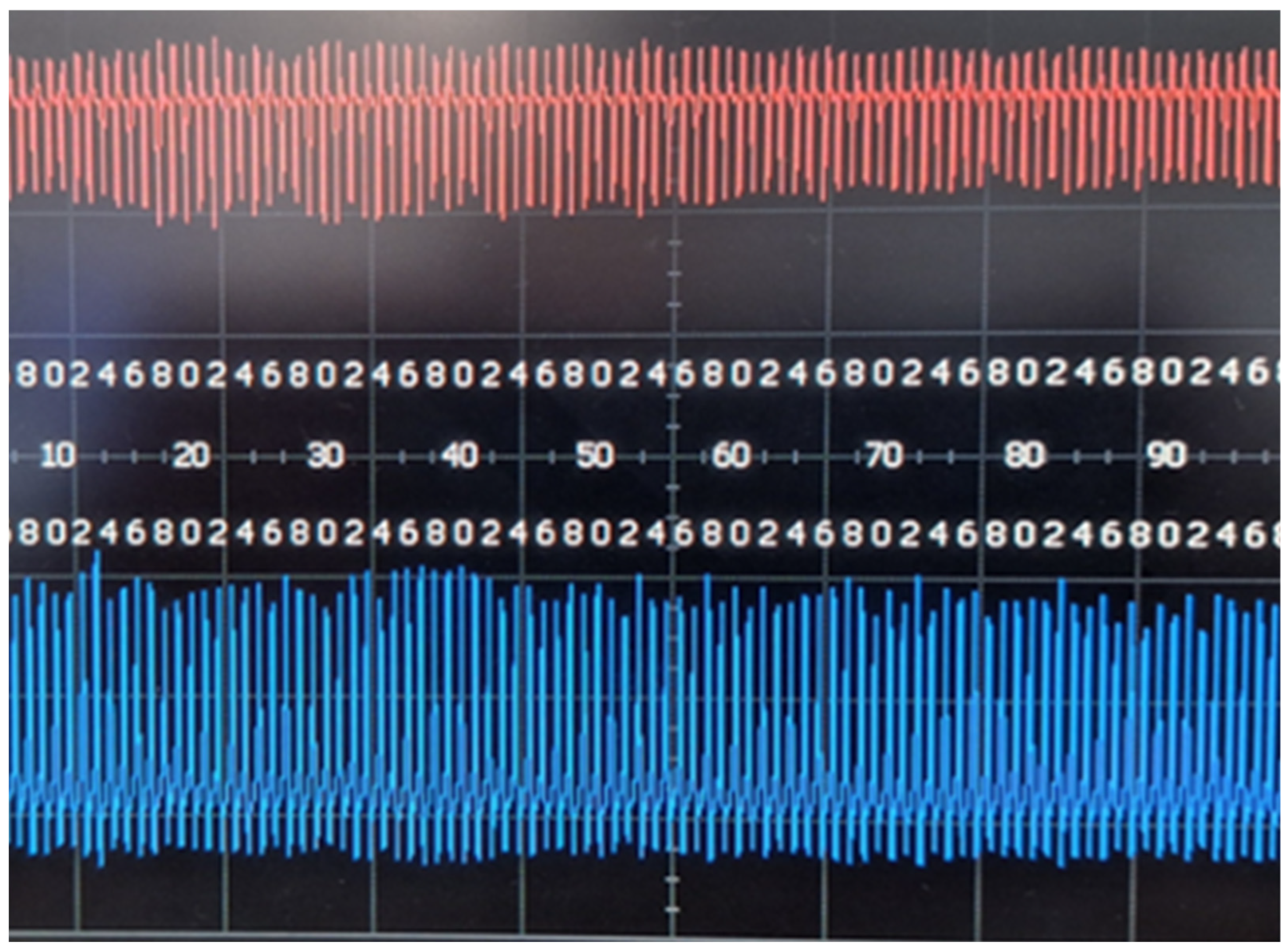





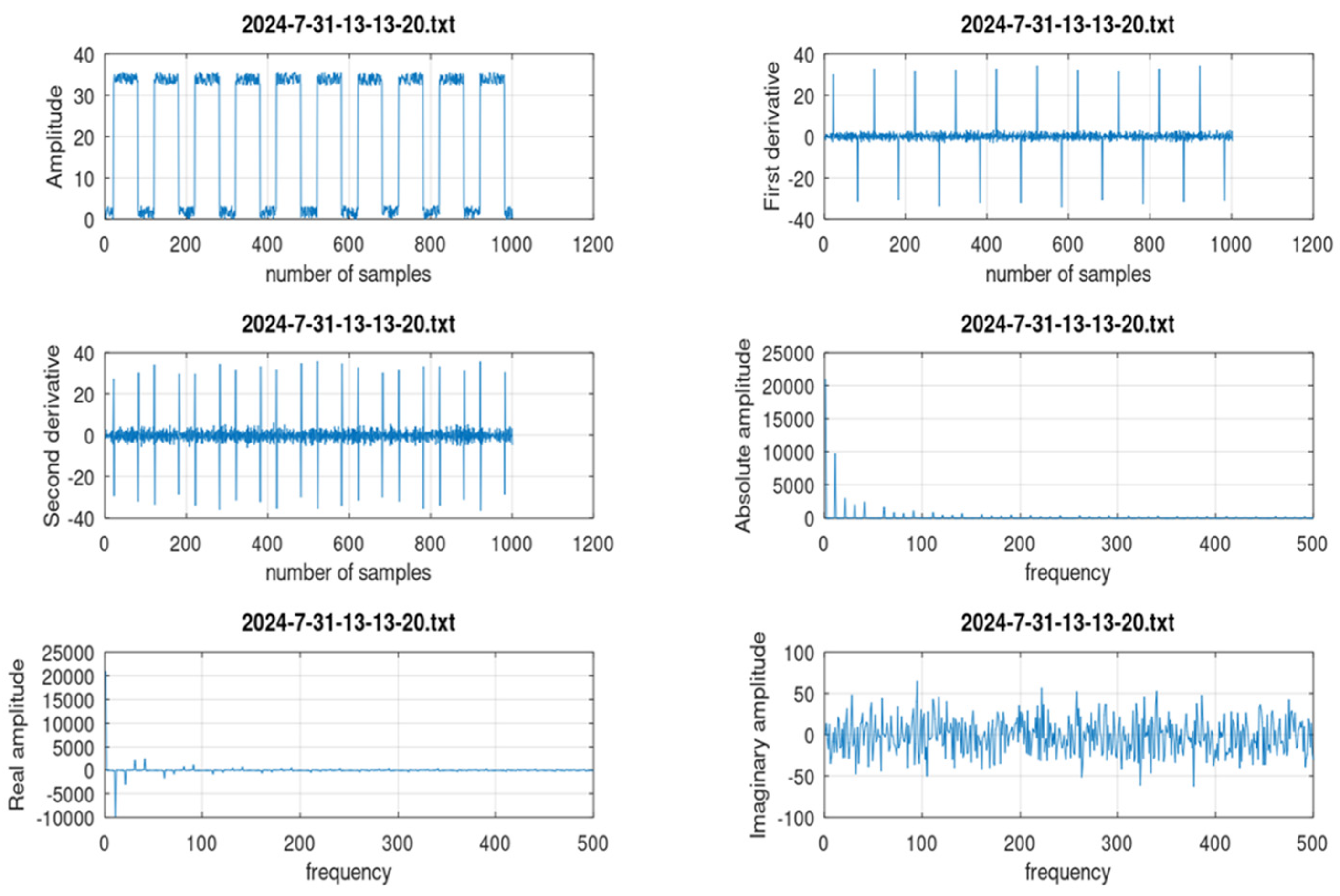
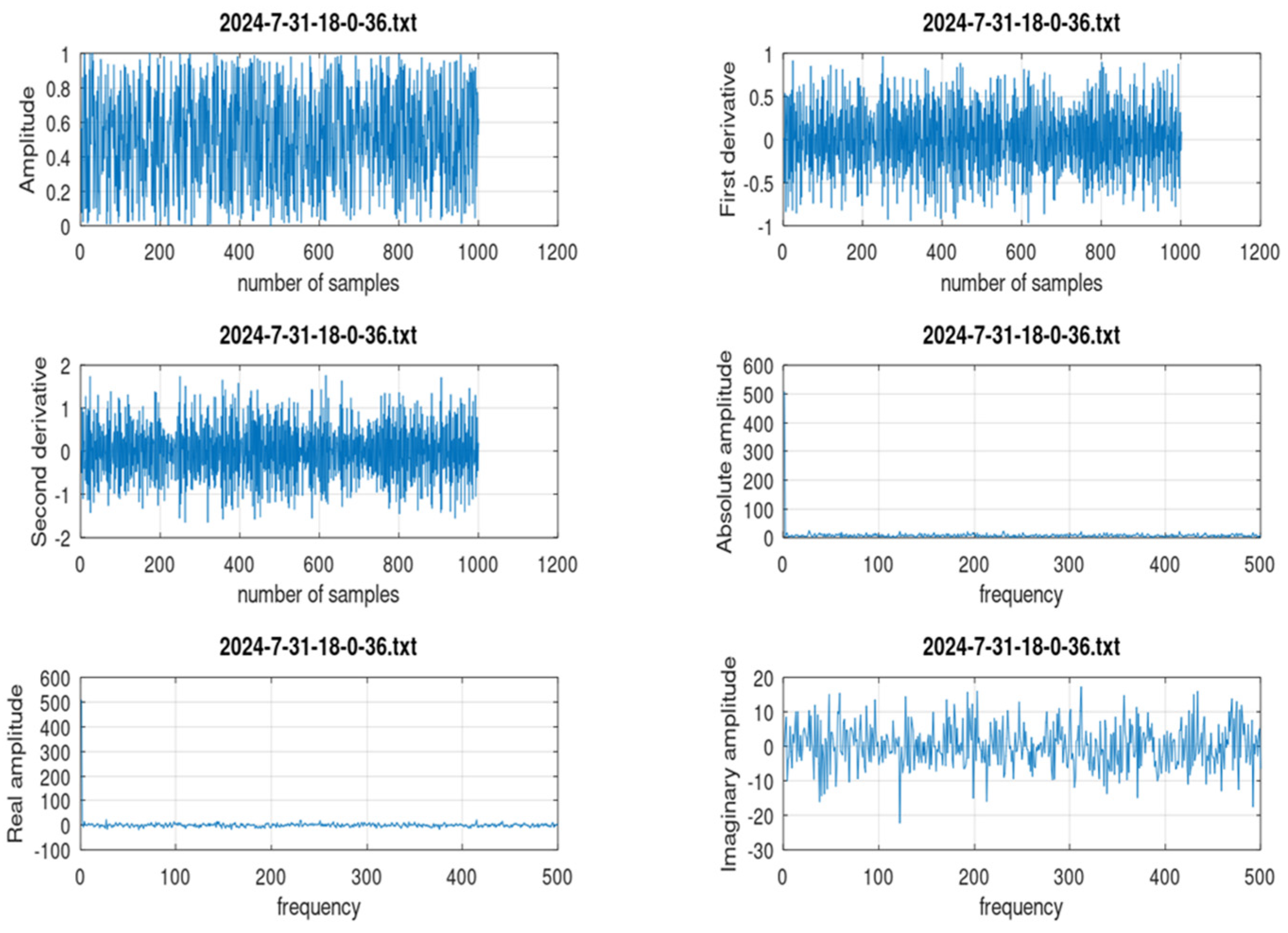

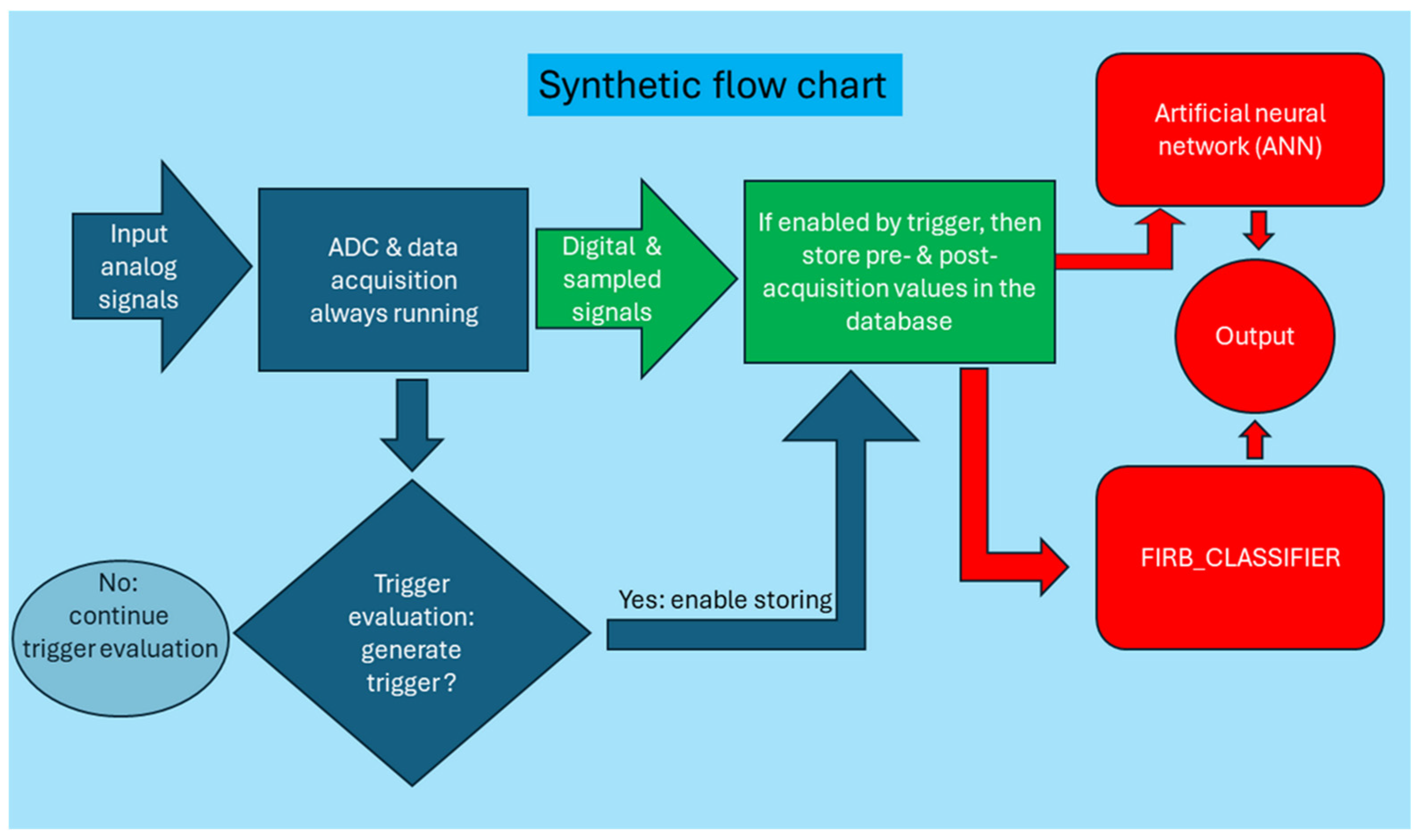
Disclaimer/Publisher’s Note: The statements, opinions and data contained in all publications are solely those of the individual author(s) and contributor(s) and not of MDPI and/or the editor(s). MDPI and/or the editor(s) disclaim responsibility for any injury to people or property resulting from any ideas, methods, instructions or products referred to in the content. |
© 2025 by the author. Licensee MDPI, Basel, Switzerland. This article is an open access article distributed under the terms and conditions of the Creative Commons Attribution (CC BY) license (https://creativecommons.org/licenses/by/4.0/).
Share and Cite
Drago, A. Fast Infrared Detector for Time-Domain Astronomy. Instruments 2025, 9, 12. https://doi.org/10.3390/instruments9020012
Drago A. Fast Infrared Detector for Time-Domain Astronomy. Instruments. 2025; 9(2):12. https://doi.org/10.3390/instruments9020012
Chicago/Turabian StyleDrago, Alessandro. 2025. "Fast Infrared Detector for Time-Domain Astronomy" Instruments 9, no. 2: 12. https://doi.org/10.3390/instruments9020012
APA StyleDrago, A. (2025). Fast Infrared Detector for Time-Domain Astronomy. Instruments, 9(2), 12. https://doi.org/10.3390/instruments9020012






